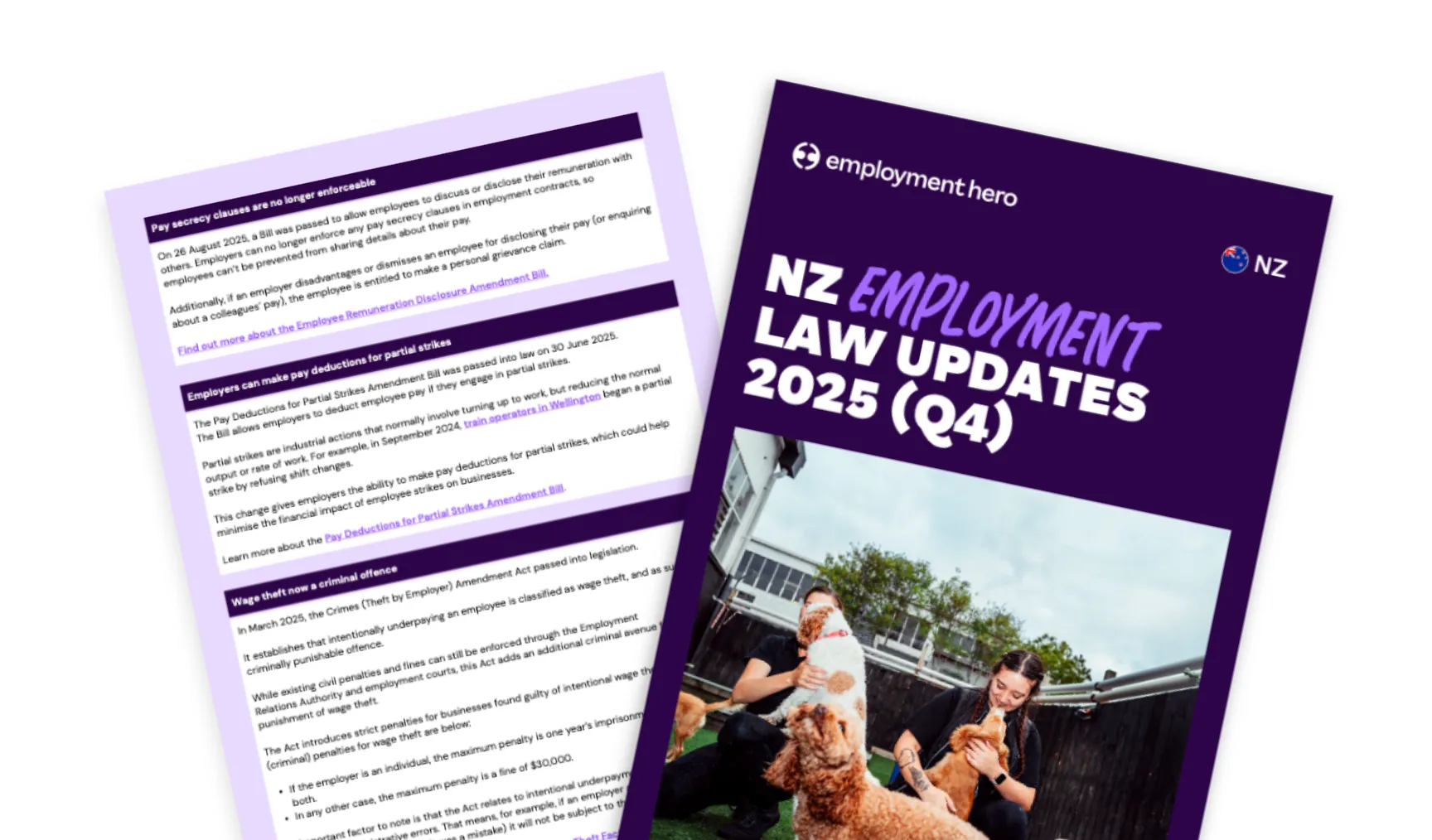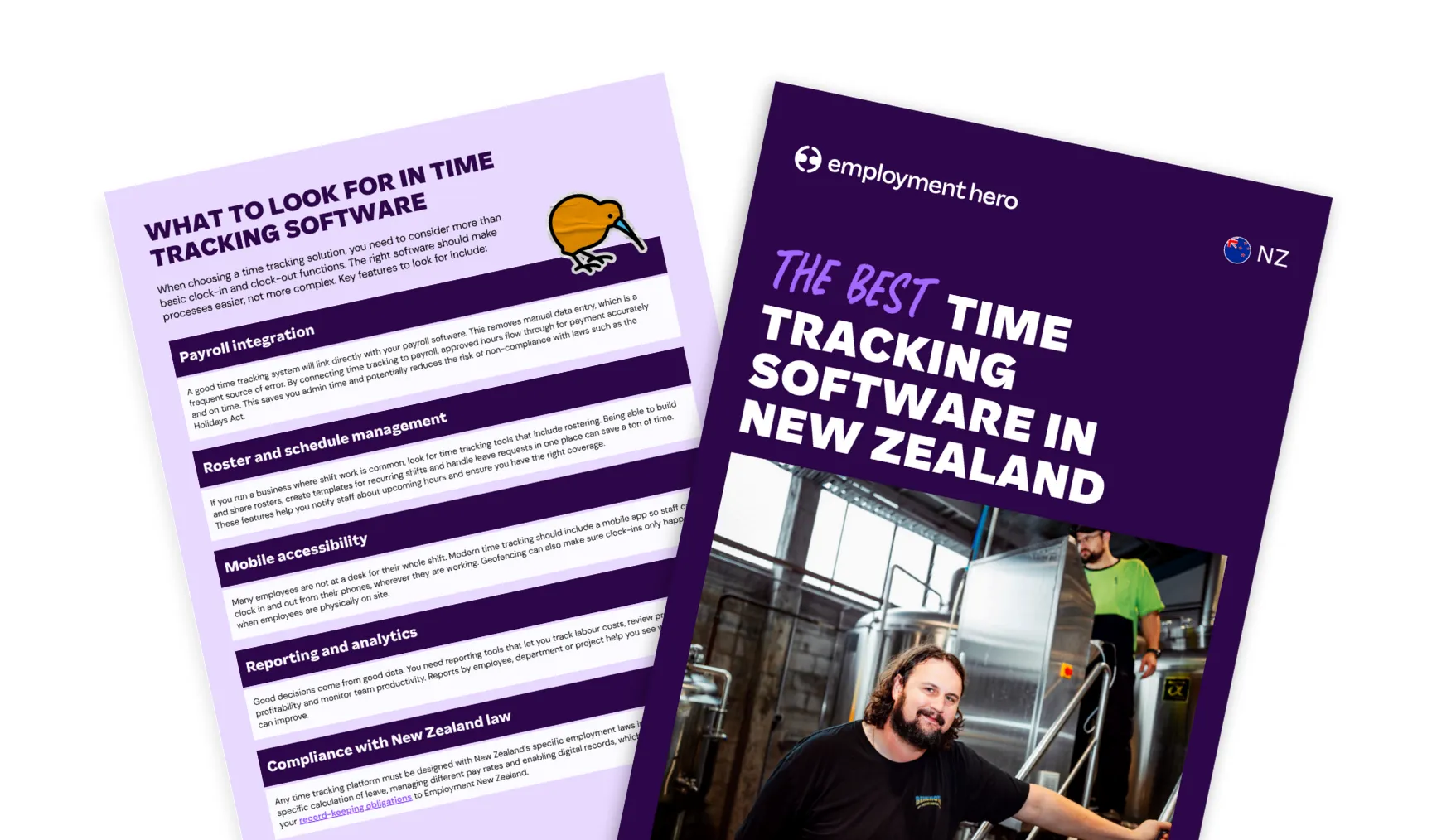How to hire temporary workers in New Zealand: Employer’s guide
Published
How to hire temporary workers in New Zealand: Employer’s guide
Businesses need flexibility. Sometimes that means bringing in extra hands for a busy season, covering for an employee on leave or getting specialised skills for a one-off project. Using temporary workers can be a smart way to manage these needs without committing to a permanent hire. But navigating the different types of temporary work arrangements in New Zealand can be complex.
That’s where our guide to hiring temporary workers can help. It covers:
- The key differences between casual employees, fixed-term employees and independent contractors.
- Legal compliance, pay and hours.
- Finding the right people.
- Managing temporary workers effectively.
Download the guide by filling in the form on the right.
What are temporary staff?
Temporary staff provide flexibility for your business, helping you scale your workforce up or down as needed. The term temporary employees refers to people who won’t be working for your business permanently, but it’s not a specific employment type. The two main types of employees that you could describe as ‘temporary’ are casual and fixed-term workers.
Casual employees work on an as-needed basis without guaranteed hours, ideal for unpredictable workloads. Fixed-term employees are hired for a specific period or project, perfect for covering leave or seasonal peaks. It is also possible to engage independent contractors for specialised, project-based work, but they are self-employed and not employees.
Why do some businesses need temporary staff?
Bringing in temporary workers can be a smart move to manage changing business demands. It helps you stay agile without the long-term commitment of a permanent hire.
Common reasons include managing seasonal peaks in tourism or agriculture, bringing in specialist skills for a specific project, covering for parental or long-service leave or filling a gap while you recruit for a permanent role. This approach allows your core team to stay focused while temporary staff handle the extra load.
Understanding New Zealand law on temporary workers
Hiring temporary employees means you still have obligations under the Employment Relations Act 2000. All employees, regardless of their employment type, must have a written agreement and are entitled to all minimum employment rights. This includes everything from using trial periods correctly to ensuring proper record keeping.
Compliance is not optional. Getting it right protects your business and ensures you treat every worker fairly.
Fixed-term employment agreements
For a fixed-term agreement to be valid, you must have a genuine business reason for the term. State this reason in the written agreement and specify how the employment will end. You cannot use these agreements simply to test a worker’s suitability for a role.
Dismissal and termination
A fixed-term agreement ends automatically on its specified date without notice, unless your agreement says otherwise. A casual engagement ends after each shift. For contractors, the end of the relationship is governed by the contract. For any complex situations or early terminations, it is best to seek professional legal advice.
Recruitment compliance
All your hiring practices must be fair and non-discriminatory, as required by the Human Rights Act and the Employment Relations Act. This means advertising roles accurately and giving all applicants an equal opportunity.
Training and development
Even for short-term roles, a good induction is crucial. Onboarding should cover health and safety, company policies and clear instructions on the tasks required. This helps temporary staff become productive quickly and feel part of the team from day one.
Work health and safety
Under the Health and Safety at Work Act 2015, you have a primary duty of care for all workers in your business, including temporary employees and contractors. This means you must provide a safe working environment, induct them on hazards and emergency procedures, and provide any necessary training or protective equipment.
Hours and pay rates
All employees must be paid at least the minimum wage. For casual staff, you can pay holiday entitlements at 8% on a pay-as-you-go basis, as long as it is in their agreement. Both casual and fixed-term employees are entitled to be paid for public holidays if it is a day they would have otherwise worked.
How to find temporary staff
Finding the right people quickly is key. You can use recruitment agencies, post ads on job boards or ask for referrals from your current team.
For a more targeted approach, a tool like SmartMatch can help. It uses AI to match suitable candidates to roles in your business, so you have a ready stream of talent available. Find out more about SmartMatch here.
Encouraging job applications
To attract the right applicants, write clear and concise job ads that highlight the main duties and what you offer. Post on platforms where your ideal candidates are active, whether that is a student job site or an industry-specific forum. AI-driven tools can help you target your ads and screen applications more efficiently.
Process for hiring, onboarding and managing temporary staff
A structured process ensures a smooth experience for everyone. Generally it’s best structured like this:
Step 1: Start with a compliant employment agreement in writing, that everyone has agreed to and signed.
Step 2: Complete a thorough induction on their first day, covering safety, systems, and key tasks. Ensure that you’ve shared relevant company policies and asked them to fill out any relevant tax and Kiwisaver forms.
Step 3: Monitor their performance with regular check-ins. Don’t forget to support their development and help with any issues, to ensure they can perform at their best.
Step 4: When the engagement ends, manage the offboarding process professionally. Leave them with a positive impression of their time with your business to protect your brand reputation.
What are the risks of hiring temporary staff?
While temporary workers offer flexibility, there are risks. These include non-compliance with employment law, such as misclassifying an employee as a contractor. There can also be challenges with integrating them into your company culture and ensuring they are productive from the start.
Knowledge is power – understand your obligations so you can meet them. You should also check that you have a clear onboarding process and compliant systems in place, to help manage these risks.
How software helps manage temporary employees
The right software makes managing a flexible workforce much simpler. Employment Hero helps you create compliant employment contracts, manage rosters, and track time and attendance. Our payroll system is aligned with New Zealand rules, supporting you in handling things like holiday pay and leave entitlements. It streamlines your admin so you can focus on running your business.
Download the full guide
Get the complete breakdown on hiring and managing temporary staff in New Zealand with our free guide. It has the in-depth, practical information you need to build a flexible workforce confidently.
Download the guide by filling in the form on the right.
The information in this article is current as at 30 October 2025, and has been prepared by Employment Hero Pty Ltd (ABN 11 160 047 709) and its related bodies corporate (Employment Hero). The views expressed in this article are general information only, are provided in good faith to assist employers and their employees, and should not be relied on as professional advice. Some information is based on data supplied by third parties. While such data is believed to be accurate, it has not been independently verified and no warranties are given that it is complete, accurate, up to date or fit for the purpose for which it is required. Employment Hero does not accept responsibility for any inaccuracy in such data and is not liable for any loss or damages arising directly or indirectly as a result of reliance on, use of or inability to use any information provided in this article. You should undertake your own research and seek professional advice before making any decisions or relying on the information in this article.
Register for the guide
Related Resources
-
 Read more: Employment law updates 2025/26
Read more: Employment law updates 2025/26Employment law updates 2025/26
Keep your business up-to-date with the latest changes in NZ employment law. Here’s what you need to know about the…
-
 Read more: Best time tracking software for NZ businesses
Read more: Best time tracking software for NZ businessesBest time tracking software for NZ businesses
Discover the best time tracking software for NZ businesses. Compare tools, find the right fit, and make time tracking simple…
-
 Read more: HR Managers: Don’t just survive the festive season, master it
Read more: HR Managers: Don’t just survive the festive season, master itHR Managers: Don’t just survive the festive season, master it
Make year-end easier: manage leave, payroll, parties and shutdowns with confidence. Get practical tips for NZ SMEs. Download the free…





















